What struck the journalists, where was it fired from, and were there any apparent military targets nearby?

On October 13th a group of journalists near the Lebanese-Israeli border line were struck by two explosions within the space of a minute. Reuters journalist Issam Abdallah was killed and the others injured, with AFP’s Christina Assi permanently disabled. A top Israeli official said its forces do not deliberately target journalists but “we’re in a state of war and things might happen,” while pledging to investigate the incident.
In collaboration with AFP, Airwars conducted an in-depth investigation of the incident. Researchers reviewed hours of footage matching key details and moments from different cameras, consulted six experts about munition remnants from the site, interviewed the reporters involved and other civilians in southern Lebanon, assessed satellite imagery, and built a 3D model to understand the geography and chronology of the strike.
The investigation sought to answer three basic questions – what struck the journalists, where was it fired from, and were there any apparent military targets nearby?
The first strike came after reportedly-Israeli surveillance drones were consistently audible near the journalists. This strike killed Abdallah and injured Assi. The second strike hit 37 seconds later and struck only a few metres from the first. Munitions experts said this close proximity all but ruled out the possibility the strikes were not deliberate.
The remnants of one of the munitions, found at the site near to Abdallah’s body, was identified by multiple experts as a fin-stabilised tank round, commonly associated with the Israeli military. No other militaries active in this area are reported to use these munitions. Analysis suggests it was fired from the southeast of the journalists, inside Israeli-controlled territory. An apparent Israeli military vehicle was visible on low resolution satellite imagery in this area.
The journalists were clearly identified and remained in an open location throughout, with a clear line of sight to an Israeli military base for more than an hour before the first strike. There was no evidence of a military target, or militant activity, near the journalists throughout that time.
Both Human Rights Watch and Amnesty International investigated the incident independently of Airwars/AFP, and their findings corroborated those of this investigation. HRW concluded that the strikes “were apparently deliberate attacks on civilians, which is a war crime,” while Amnesty said the incident was “likely a direct attack on civilians that must be investigated as a war crime”. Israel did not respond to AFP’s request for comment in time for publication.
Around 4.30pm on October 13th, Lebanese news stations reported on a possible infiltration attempt by a Palestinian militant group into Israel, with retaliatory Israeli shelling in Lebanon.
Two journalists from Al Jazeera – Carmen Joukhadar and Elie Brakhya – were searching for a safe place to film the areas being hit by Israeli strikes. They stopped on a hill outside the village of Alma al-Shaab. From here they had a clear view, but were more than a kilometre away from the nearest Israeli base.
Brakhya knew the region well as he covered the 2006 war between Israel and Hezbollah, the militant group that dominates southern Lebanon. They chose the location as it was “clean… meaning it is not covered in trees, it can’t be [seen as] suspicious from a military perspective,” Brakhya said. “It would be difficult to have any military site there – it is a hill with two houses, nothing can be hidden there.”
At 4:54 pm Carmen Joukhadar did a live piece for Al Jazeera – the most popular Arabic-language news channel. Six days earlier, Hamas militants had entered Israeli territory and killed more than 1,000 people, sparking retaliatory strikes on Gaza in which thousands of Palestinians had already been killed. Millions across the Arab world were watching Lebanon to see whether tensions between Hezbollah – a Hamas ally – and Israel might tip into full scale conflict and spark a fresh front in the war. Joukhadar told the viewers the day had been calm, but Israeli shelling had begun in the past half hour.
Shortly after, two AFP journalists and three from Reuters – two of the world’s largest news services – arrived at the site, joining the Al Jazeera team. Reuters had cleared the location with its security team, the journalists said. All seven of the reporters were clearly identified as such – wearing press vests and helmets. The Reuters car was also marked TV along the side and top.
In all of the footage reviewed by Airwars and AFP, there is no indication of military activity near the journalists. Airwars and AFP also interviewed six of the journalists at the site and each said they saw no military activity near them at any time. The nearest Israeli strike in the hour before was geolocated to around a kilometre from the journalists.Between 5:30 and 6pm Israeli strikes intensified – with around 25 separate strikes heard on the journalists’ videos. Audio analysis conducted by three separate sound analysis firms for Human Rights Watch identified the sound of drones and helicopters hovering above the reporters in their camera footage. According to the audio analysis, a drone circled the reporters’ site 11 times in the 25 minutes before the first strike.Military experts consulted by Airwars suggested that it was reasonable to assume the area was under continuous surveillance by the Israeli military.“The newsgathering teams had been at that location for some time, were static, were wearing distinctive blue PPE (personal protective equipment) and obviously unarmed,” said Chris Cobb-Smith, a security consultant and former artillery officer in the British army. “I would expect the reporters to have been fully visible to the IDF.”Cobb-Smith emphasised that the presence of Israeli surveillance drones further supported this observation. “A UAV would not only have located them, but with advanced surveillance capabilities they would easily be identified as media and therefore not a legitimate target,” he said.A little more than two minutes before the first strike, the journalists noticed smoke rising across the valley on the Lebanese side of the border towards the west. To capture the scene they adjusted the angle of their cameras southwest.AFP and Reuters were broadcasting live from the location and began filming the Hanita Israeli military base just over the border line – around 1.2 kilometres away. Around 6pm, an Israeli tank inside the base fired on a target inside Lebanon – several kilometres west of the journalists. In Reuters footage from the day, the tank can clearly be seen firing, and then moving to another location within the base.
Using footage and testimony, Airwars and AFP reconstructed the scene to understand how the journalists were standing at the time of the incident.

Right to left: Thaer Al-Sudani (Reuters), Issam Abdallah (Reuters), Christina Assi (AFP), Maher Nazeh (Reuters), Elie Brakhya (Al Jazeera, back), Dylan Collins (AFP, front left), Carmen Joukhadar (Al Jazeera).
The first strike appears to have come from behind the journalists and hit the stone wall they were lined up along directly. Abdallah, who was positioned against the wall, was killed instantly. His body was pushed to the west towards the Hanita base, where it lay among the fragments of the wall. This suggests that the first strike originated from the east.
In photos from the scene, a large munition remnant can be seen amongst the debris of the wall – 2-3 metres from Abdallah’s body. It has been marked in blue in Airwars’ model.
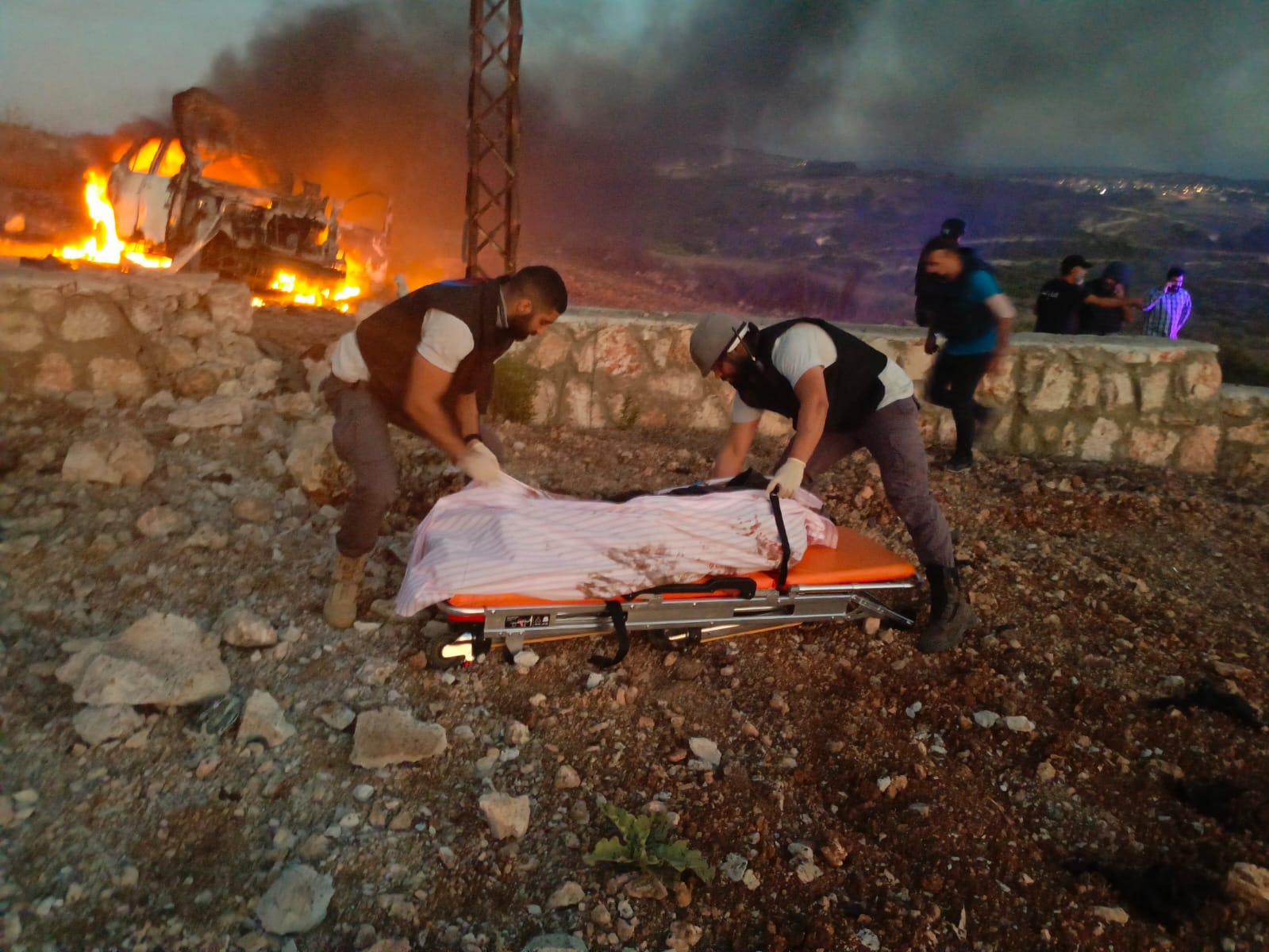
An image of Abdallah’s body being taken away. The munition remnant is visible in the bottom left corner of the image (Image source: AlJadeed)
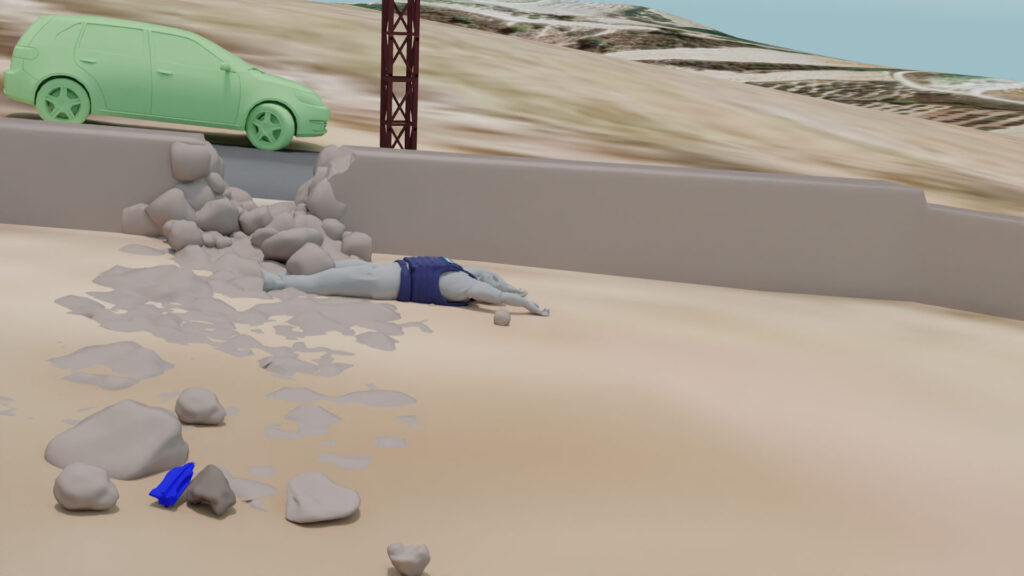
Airwars recreated the scene to better understand the geography of the attack
Airwars and AFP took images of the munition to six separate munitions experts. Each independently concluded the remnant was a 120mm fin-stabilised tank round of the type produced by an Israeli company and are typically used by the Israeli military. They are typically fired from Merkava tanks – a type used by the Israeli military.

Images of the munition: Source AFP
The Lebanese military, which operates in this area, and Hezbollah do not use this type of ammunition.
Similar munitions have been documented multiple times in Gaza, including after both the 2009 and August 2022 wars between Israel and Hamas, the Islamist movement which controls the Gaza Strip. Similar munitions have also been documented multiple times since October 7th, both in Gaza and Lebanon. In all cases, the strikes were Israeli.
“I am sure about this munition, because I have looked at those extensively and have photos of fragments looking very similar to that from previous Gaza wars,” said Chris Cobb-Smith, who conducted field research into previous conflicts in Gaza. He also provided Airwars with photos of tank rounds with a similar type of tail fins from Gaza in 2009.
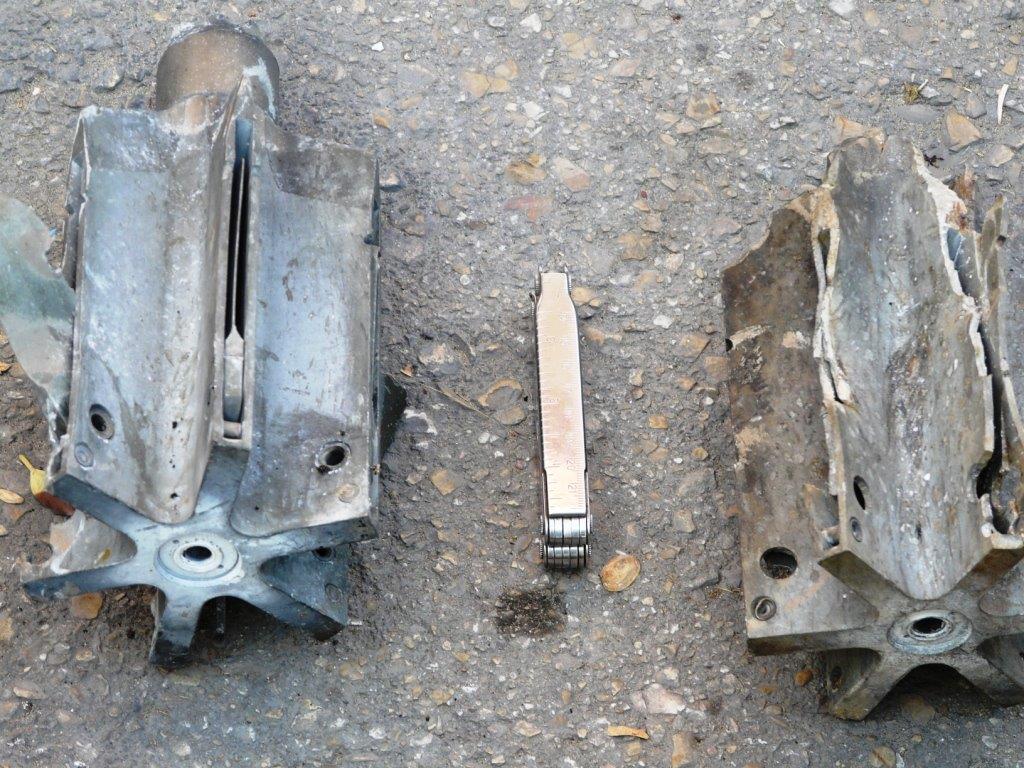
An image of comparable munitions from 2009. Copyright: Chris Cobb-Smith
Israel’s military has confirmed it used tank and artillery fire in the area that day to prevent an infiltration from Lebanon.
The second strike occurred 37 seconds after the first and caused a car belonging to Al Jazeera to explode, as well as seemingly leaving a crater on the road.
According to the reporters on the scene, before the strike the car was parked by the side of the road. After the strike, it had rotated almost 90 degrees, and a fresh crater created. The car showed signs of being impacted on its front left side.
Analysis conducted by Airwars suggests it is likely that the strike came in a low angle from the east and hit the front left side of the car before landing in the road.
The two strikes thus appear to have come from approximately the same direction.
Retired Irish Army colonel Desmond Travers indicated that the 37 second gap between the strikes aligns with the time it can take to reload a tank. He thus thought it was likely that both strikes came from the same tank and crew.
“It is most unlikely that this was a misfire or error,” said Travers, a former United Nations investigator in Gaza and former director of the Institute for International Criminal Investigations in the Hague. “It may be likely that the first round missed the vehicle, hence the firing of a second shell which achieved its purpose.”
Other arms experts highlighted that the impact on the front engine of the car suggests it was the intended target.
“If you are going to hit a car you always do an engine shot,” said a former British military Lieutenant Colonel, who asked to remain anonymous.
In photos of the crater from the second strike, several items are visible that could potentially be munition remnants. Two experts Airwars consulted pointed out that the remnants appear to be of a different type of metal than that from the first strike. One suggested that they looked like they could be from a smaller munition, including a missile.
However, none of the images was good enough quality to allow a definitive conclusion as to the munition type. Without access to munitions remnants, which are currently believed to be in the possession of the Lebanese authorities, it is impossible to determine exactly what weapons system or munition was used in the second strike.
With the munition from the first strike identified, it was necessary to pinpoint where it was fired from. The debris pattern of the wall blew debris 8-10 metres toward the west, with the remnant of the munition in this same location.
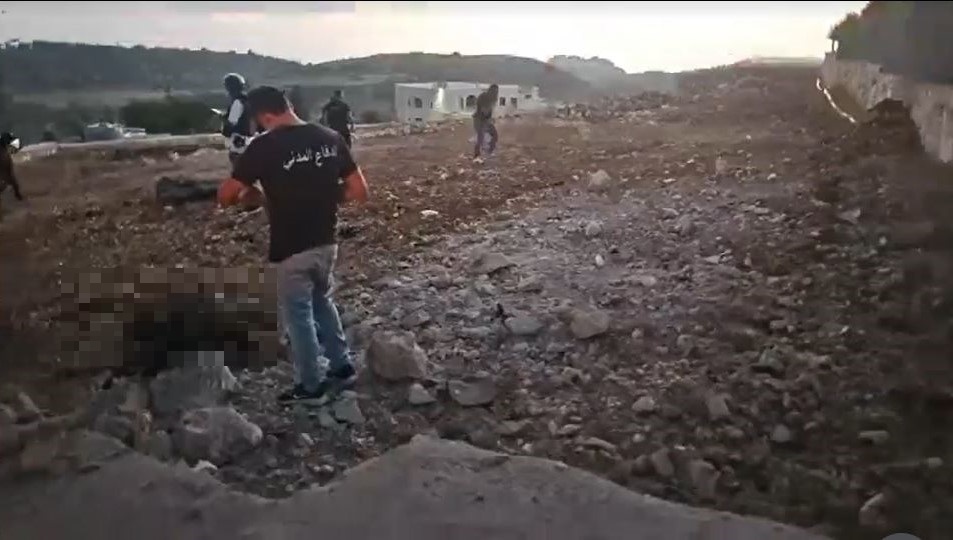
Wall debris blown towards the west. Image from Lebanese media SBI’s live feed from just after the strike. Abdallah’s body has been blurred. Copyright: Sawt Beirut International
This indicated clearly that the munition came from behind the journalists – the east. This conclusion was corroborated by all of the munitions experts Airwars consulted.
This ruled out the possibility of fire from the Hanita base itself – which was directly in front of the journalists. At the time of the strike, the journalists were facing southwest towards Hanita, where Israeli forces were striking targets inside Lebanon – located to the west of the journalists.
A vital clue came from analysis of the footage from the different news organisations. Around 45 minutes before the journalists were hit, both AFP and Reuters’ cameras captured the sound of a strike which prompted the videographers from both organisations to point their cameras southeast.
While Reuters’ camera seemingly captured the spot where the shell landed inside Lebanon, AFP recorded what appeared to be smoke after an outgoing strike originating from inside Israeli-controlled territory.
Airwars geolocated the smoke seen in the AFP camera, and it appeared to have come from the area near the Israeli village of Jordeikh. The location inside Lebanon that was hit was southeast of the reporters. This suggests that Israel was firing from the southeast in the same broad direction as the reporters, approximately 45 minutes before the reporters were hit. The site where the munition landed was about one kilometre from the journalists.
To seek to verify if there was an Israeli tank presence in the area near Jordeikh that day, Airwars and AFP sought satellite imagery of the area.
The US generally prohibits the sale of the highest-resolution imagery of Israel by American-based companies, and other governments have similar restrictions. However, Airwars obtained two lower resolution satellite images of the area around Jordeikh from that day via the satellite image providers SkyFi and Planet.
Even with lower resolution imagery, Airwars was able to identify armoured vehicles in the area by their shape and dimensions. The first image, captured at 11:06 am local time by Planet, showed the presence of at least one armoured vehicle near to the estimated origin of the strike. In the second image at 2:21 pm, by SkiFi, less than four hours before the journalists were hit, a military vehicle was observed at the side of the road just 30 metres from the area where Airwars estimated the 5:15pm firing could have come from.
The audio analysis conducted for Human Rights Watch examined the muzzle fire sound in the reporters’ footage and compared it to recordings from a nearby camera team of a Lebanese news channel. The analysis concluded that the shots came from a distance of 1.45 to 1.8 kilometres away. The object captured in the satellite image is 1.62 kilometres away.
The following morning, two vehicles were present at the same location on a satellite image provided by Planet. Due to the resolution of the images, a definitive identification of the vehicles is not possible, but the dimensions may correspond to that of Merkava tanks, according to assessment by open source researcher Gabòr Friesen and Airwars.
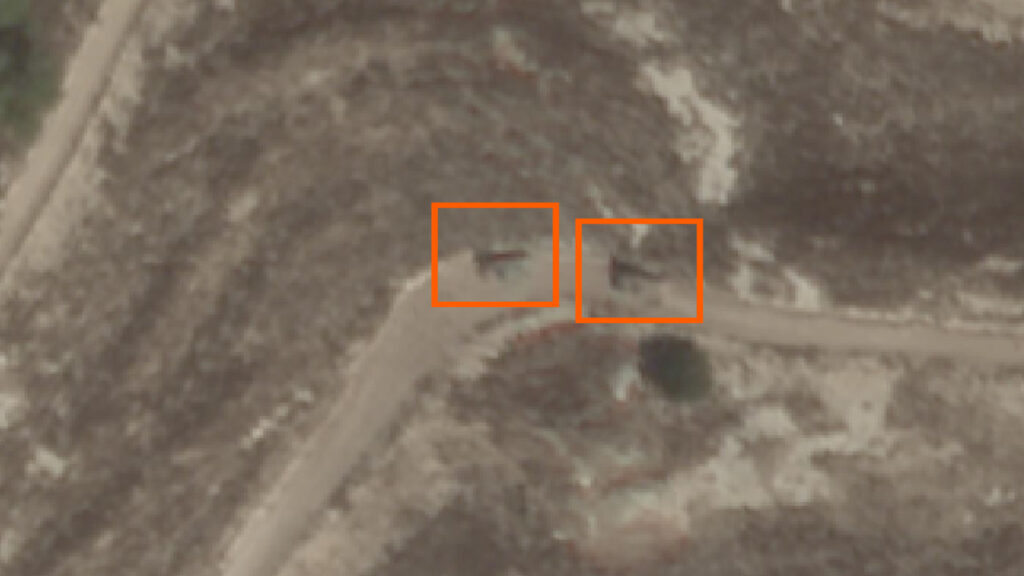
Two armoured vehicles on the following morning southeast of where the reporters were situated. Copyright: Planet Labs PBC
This investigation, conducted by Airwars and AFP, found that the group of journalists were struck twice while carrying out routine journalistic work far removed from any military targets. The munition from the first strike was identified as a fin-stabilised tank round of the type typically used by the Israeli military. The images of the munition from the second strike are inconclusive. However its close proximity to the first – both in time and geography – and the presence of Israeli surveillance drones in the area, limits the possibility of an accident.
The evidence suggests the journalists were deliberately hit.
Amnesty International and Human Rights Watch have also conducted investigations into the incident independently to Airwars/AFP. The groups both concluded that the strikes were potential war crimes. Amnesty’s Aya Majzoub, Amnesty International’s Deputy Regional Director for the Middle East and North Africa, said their investigation found “chilling evidence pointing to an attack on a group of international journalists who were carrying out their work by reporting on hostilities.”
“No journalist should ever be targeted or killed simply for carrying out their work,” she added.
“This is not the first time that Israeli forces have apparently deliberately attacked journalists, with deadly and devastating results,” said Ramzi Kaiss, Lebanon researcher at Human Rights Watch. “Those responsible need to be held to account, and it needs to be made clear that journalists and other civilians are not lawful targets.”
AFP presented the findings of this investigation to officials. Israel did not reply to a request for comment by the time of release.
Since the attack, two further journalists in Lebanon are alleged to have been killed by Israeli strikes. On November 21st, two journalists working for the Al-Mayadeen channel were hit directly by a strike in southern Lebanon. More than 60 journalists have been killed in Gaza, Israel and Lebanon since hostilities broke out on October 7th, according to the Committee to Protect Journalists – the vast majority in Gaza. The first month of the war was the deadliest month for journalists since CPJ began gathering data three decades ago.
Editor’s note: This article was amended on December 8th to reflect the fact that Hezbollah has been known to use tanks, though not the kind of ammunition used in this strike. The original version said Hezbollah did not have tanks.